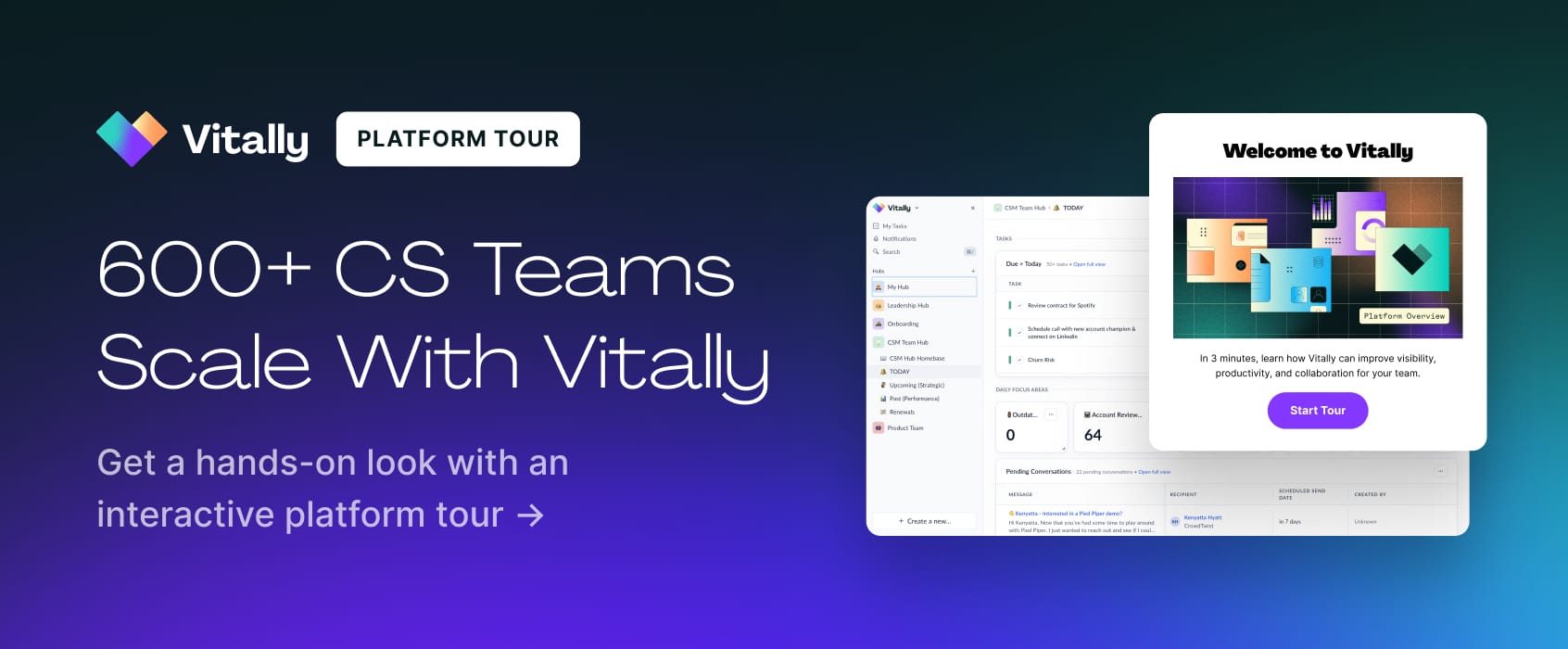
Article Overview
- Why formalize your CS process: Without structure, Customer Success becomes reactive, inconsistent, and difficult to scale — formal processes drive retention, efficiency, and trust at every stage of the customer journey.
- When you know it’s time: Rising churn, repeated support issues, rapid team growth, or increasing product complexity are strong signals that your current approach won’t hold up without a scalable foundation.
- What it takes to build it: From stakeholder buy-in to modular playbooks, automation, and continuous iteration, we break down 10 actionable steps to help you design a CS process that grows with your business.
If you’re managing Customer Success with a whiteboard, a shared doc, and some goodwill, your CS function might already be under strain. And if your team is growing, churn is creeping up, or customers are slipping through the cracks, you know it’s time to formalize your Customer Success process.
This isn’t about adding red tape. It’s about giving your team a scalable framework that delivers consistent outcomes, for your customers and your business.
Let’s break it down: why processes matter, when to build them, how to start, and what it looks like in the real world when it’s done right.
When Is It Time to Formalize Your CS Process?
You don’t need to be a 200-person SaaS company to need processes. According to experts like Tom Maxwell (Ignition), a few clear signs indicate you’re overdue:
You’re Seeing Customer Churn
If customers are dropping off, chances are they’re not seeing value. A defined process, especially around onboarding, check-ins, and lifecycle management, ensures your team isn’t relying on memory or guesswork to guide customer success.
Your Support Tickets Are Piling Up
When support is reacting to the same questions repeatedly, that’s a signal to improve upstream processes — better onboarding, clearer communication, smarter knowledge bases.
Your Business Is Scaling and Things Are Getting Messy
What worked when you had a handful of CSMs starts to unravel as new hires come on board and account volume increases.
Without standardized workflows, you’ll see inconsistent outcomes, onboarding bottlenecks, and overreliance on your most tenured team members.
As Parker Moore, Director of Customer Operations at Vitally, puts it: “We need formalization to scale and to unlock the full potential of our teams.”
Your Product Is Getting More Complex
When you introduce new pricing tiers, products, or target segments, your CS strategy needs to evolve too. Treating a self-serve SMB the same as a strategic enterprise customer simply doesn’t work.
Complexity requires segmentation, specialized touch models, and process-driven playbooks to meet customers where they are. Without this, your team ends up reinventing the wheel for every new use case and burning out in the process.
How to Build a CS Process That Scales (in 10 Steps)
A great Customer Success process doesn’t start with tools or templates. It starts with clarity: clarity of purpose, ownership, and value. Here's how to build a process that scales with your business (and your customers).
1. Get Stakeholder Buy-In Early and Often
CS doesn’t operate in a silo. To succeed, your process must align with product, sales, support, finance, and marketing. That alignment starts with bringing stakeholders in from day one.
What to do:
- Host a kickoff session to frame the CS process initiative as a strategic, company-wide effort.
- Share the business case using data: rising churn, inconsistent outcomes, poor adoption, or growing headcount.
- Ask for insights. What are other teams hearing from customers? What internal blockers are they seeing?
Pro tip: Use real metrics, such as CAC, onboarding time, time-to-first-value, renewal rates to create urgency. Position your process as a growth enabler, not a cost center.
2. Know Your Product Inside and Out
A CS process can’t succeed if it’s built on incomplete or outdated knowledge of your product. CSMs are product translators, they connect use case → feature → outcome.
What to do:
- Document use cases for your top customer segments.
- Create internal training modules on workflows, integrations, and upcoming roadmap items.
- Collaborate closely with Product Marketing to stay aligned on messaging and value propositions.
Pro tip: Encourage your CSMs to use the product deeply, not just demo environments. Real-world usage builds empathy and insight.
3. Understand Your Customers Like a Strategist
Every process you build, from onboarding to renewals, should be grounded in customer context. That requires more than surface-level knowledge.
What to do:
- Segment your customers meaningfully (e.g., industry, ARR, lifecycle stage, use case maturity).
- Interview 5-10 customers per segment to understand goals, friction points, and workflows.
- Map success criteria for each persona: What does “value” look like to them?
Pro tip: Use your Customer Success Platform (CSP) to surface behavioral patterns across cohorts (e.g., time to activation, feature usage decay, engagement drop-off).

4. Define Success Metrics Before You Build
If you can’t measure success, you can’t optimize. And if you can’t connect CS to revenue, leadership won’t invest in it.
What to do:
- Select high-level business metrics (e.g., net revenue retention, logo churn, expansion revenue).
- Pair each with leading indicators (e.g., onboarding CSAT, time-to-value, usage frequency).
- Set targets and review them quarterly.
Pro tip: Track churn type, not just churn rate. Losing customers because of poor onboarding requires a very different fix than losing them to budget cuts or M&A.

5. Prioritize and Sequence the Right Processes
You can’t solve everything at once. The most effective CS leaders tackle the highest-impact, most-timely processes first.
What to do:
- Identify where breakdowns are happening (e.g., onboarding takes 6 weeks instead of 2).
- Use a prioritization matrix: rank by business impact, effort, urgency, and risk of inaction.
- Start with one high-leverage process, like onboarding or renewals, and build from there.
Pro tip: Look for “fear factors.” Where are CSMs hesitant? Renewal conversations? Upsells? Those often signal a lack of structure or confidence and are ripe for process.
6. Design Modular, Scalable Playbooks
A good process is modular. You can adapt it for different segments or product lines without reinventing the wheel.
What to do:
- Build your playbooks around clear entry/exit criteria (e.g., onboarding starts when a contract is signed; ends at first value).
- Define responsibilities using RACI or DACI models.
- Include templates, scripts, customer-facing collateral, and internal notes.
Pro tip: Diagram the workflow. A visual flowchart, swimlane diagram, or wireframe makes cross-functional handoffs clearer and highlights automation opportunities.
7. Pilot First, Then Launch with Intent
Skipping the pilot phase is the fastest way to ensure your process gets ignored. Early feedback is gold.
What to do:
- Roll out your process with a small group of CSMs and customers.
- Measure outcomes and collect qualitative feedback.
- Iterate fast! Improve documentation, clarify steps, and remove friction before going wider.
Pro tip: During pilot, record actual calls (via Gong, Zoom, etc.). These become powerful examples when training the broader team.
8. Train, Reinforce, and Normalize the Process
People don’t adopt processes just because they exist. They need to understand, trust, and be accountable to them.
What to do:
- Deliver live training for every major process. Include roleplays, Q&A, and real examples.
- Build reinforcement into 1:1s and team meetings. Review adoption metrics, highlight wins, and tackle objections.
- Embed process steps into your CSP with automations, tasks, and notifications.
Pro tip: Tie MBOs or variable comp to adoption (e.g., % of QBRs completed, % of accounts onboarded on time). Use dashboards and leaderboards to create visibility and healthy peer pressure.
9. Automate Where Possible, But Stay Human
CS needs to scale without losing the human touch. The right automation supports, not replaces, strategic CSM work.
What to do:
- Automate repetitive workflows: onboarding tasks, check-in reminders, success plan creation.
- Trigger success plays based on product usage, renewal windows, or risk indicators.
- Use in-app guidance and content to handle low-touch or self-serve segments.
Pro tip: Ensure automations are intelligent and adaptive, so segment-specific messaging, dynamic checklists, and customer-specific triggers outperform generic sequences.
10. Measure and Iterate Relentlessly
A process that worked last year might not work today. Your team evolves. So do your customers. So should your playbooks.
What to do:
- Set review cadences (quarterly is a good default).
- Use both metrics and qualitative input to refine processes.
- Celebrate improvements and show the team that iteration leads to better results and easier work.
Pro tip: Assign process “owners” who are accountable for keeping documentation up-to-date and improvements in motion. Don’t let great processes go stale.
Real Examples of What a Good CS Process Looks Like

FreightWise: Formalizing Renewals with Purpose and Precision
At FreightWise, a growing transportation SaaS company, renewals had long been handled ad hoc or not at all.
When the company realized that a significant number of customer contracts were set to expire within the same window, the CS team, led by Jennifer Demenus, saw both risk and opportunity. Rather than scrambling, they treated it as a chance to build something better.
They started by mapping out every step of the renewal process: who initiates it, when it starts, how progress is tracked, and what a “successful” renewal looks like. A RACI chart made roles and responsibilities crystal clear.
They standardized email templates for outreach, created dashboards in Vitally to track renewal status across accounts, and implemented variable compensation based on contract length — incentivizing multi-year agreements.
The result? Not only did the team renew every targeted customer over an 18-month period, but most renewals came with improved terms for FreightWise.
What was once a looming operational gap turned into a repeatable engine for retention and growth — all because they formalized a process that had previously relied on gut feel.

Ignition: Doubling Down on the First 90 Days
Ignition, a platform widely used by accounting and tax professionals, has learned that customer retention is won (or lost) in the first few weeks.
Through years of iteration, they’ve come to understand that early engagement with core functionality directly correlates with long-term success. Specifically, if a new customer sends a proposal or collects a payment through Ignition within their first month, they’re significantly more likely to stay.
Armed with that insight, the CS team built a process that aggressively prioritizes time-to-first-value. Every onboarding motion is designed to help the customer achieve one of these “sticky” milestones as quickly as possible. From proactive onboarding sequences to personalized outreach and contextual education, nothing is left to chance.
The team also recognized the seasonality of their customer base.
For many, tax season is the most critical (and stressful) time of year. So Ignition ensures that customers in their first tax cycle receive white-glove support. By leaning in during these peak moments, Ignition not only improves outcomes, but reinforces their product’s value when it matters most.
Retention, while important, is almost a byproduct. As CS leader Tom Maxwell put it: “We grow if our customers are growing.”
Make Your Process Your Superpower
Creating a Customer Success process is only the beginning. The real impact comes when that process becomes second nature — embedded in how your team operates, how your company aligns around customers, and how you drive outcomes at scale.
That doesn’t happen by accident. Success requires clear communication, visible adoption metrics, aligned incentives, and a commitment to continuous improvement.
When your process works, it doesn’t just prevent churn or drive efficiency, it builds trust. The kind of trust that, as Tom Maxwell says, earns you the keys to the customer’s office.
That’s what great Customer Success looks like, and that’s what Vitally is built to support. Our platform helps teams operationalize every part of the CS journey with automation, visibility, and real-time data that scales with you.
Ready to put structure behind your strategy? Request a demo or explore the product tour to see how Vitally can power your next phase of growth.










